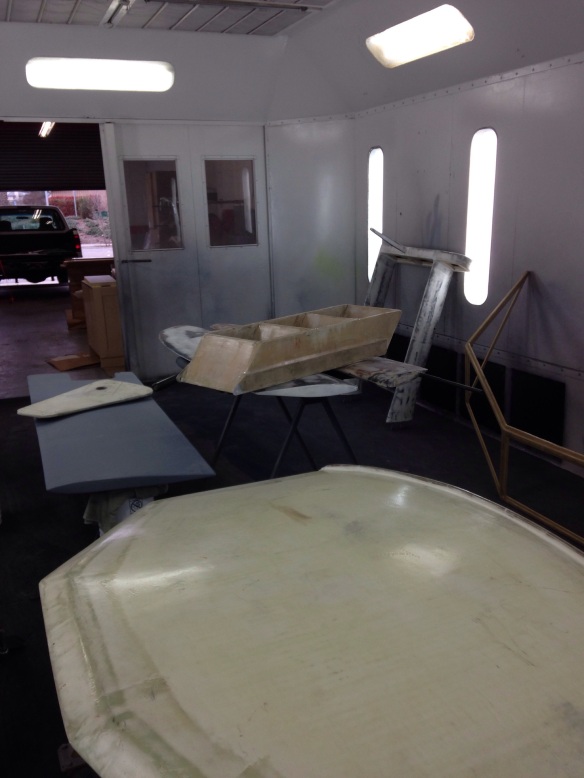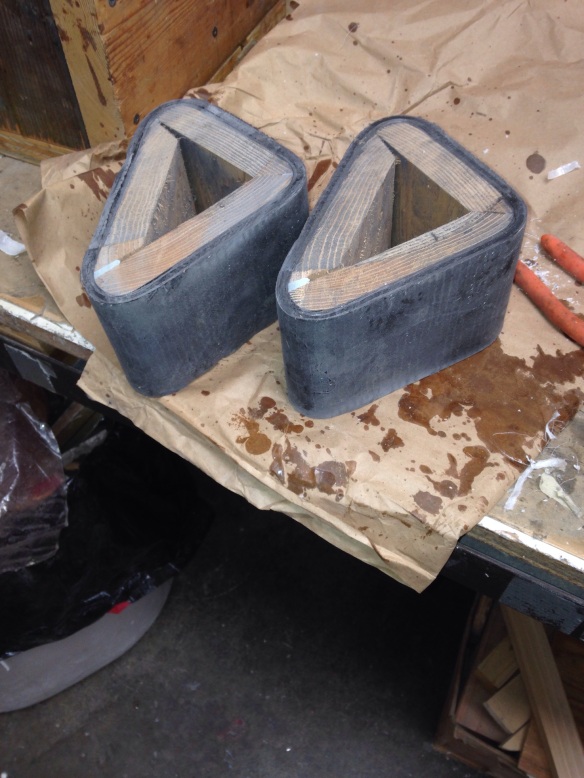Well, that exterior build punch list is down to just a few things like a pulpit on the bow and a wood plate under the mast base. Short enough to move on to the cabins, and finish up outside in between other projects. Here’s how the past week went down…
The boom is done and ready for paint. This was a really satisfying project, remaking this spar from Transit of Venus’ original mast.
The control lines for three reefs plus the outhaul live inside the boom.


The hole on the end of that last photo will hold a spectra loop to catch the topping lift. Three reefs around the sheaves in back, with the outhaul just ahead. Here’s the boom end with line guides inside, before capping the end permanently.


And despite Charlie’s reluctance to cut holes in a friend’s boat, I got him to make these nifty exit holes after we tried out a few design options. (Got a little inspiration from a GM Futureliner restoration show)

Next up was replacing a hatch on the port float bow (that unfortunately went missing when we moved the hulls 3 years ago). We took the inspection port off the starboard one and used it as a mold to get the curve right.


This will now sit idle until a new 10″ port shows up to match the existing one.

And up in the cockpit, we finished up more details. All six winches are now mounted; this mid-cockpit pair will handle the reacher and spinnaker sheets. The barber hauler controls are just ahead of the winch, and check out the new little pods for the compasses – there’s a duplicate of this over on the port side. Seems like a good spot, up and out of the way of seated crew / guests, and right in the sight lines of the driver from either down in the cockpit or out on the beams and/or nets.

Speaking of the nets – they’re here! Recall last fall we saw F22 Dart’s at the first launch, and we followed up in purchasing 30lbs of Dyneema mesh. Yes, these are fishing supply people that sell it by the pound. This same stuff was on the America’s Cup boats last year, and doing it this way is costing about 1/3 or ordering complete trampolines from known suppliers in FL, etc.


Work this week in the main cabin shows progress quickly because each task is smaller. We’ve figured out a BlueSea 12volt electric distribution system, and the complete panel will live here above the radios and chart table.

The galley is figured out now. The propane stove/oven unit got it’s mounting built (but installed photo forgotten). The metal trim of the unit fits right over the raised wooden rails and trims out nicely.

Then looking to the left, we get a big, deep sink – after all, this is a second home, right Dad? The circle left of the sink is a garbage can built in to the countertop, so Jimbo can say it’s a real boat. And the freezer unit is at your far left in the photo.

In the sink there’s a very deep strainer basket – that’s important to catch any food scraps as the drain water is set up for a grey water catch tank which will supply the toilet flushing. When we have a few gallons of “grey” stored up, the sink will be switched to drain overboard, via reachable levers in the cabinet. More on that later.

I noted in F39 Henny’s and F33 Arno’s blogs recently each spoke of it taking about three hours to get vacuum’d panels all set up and working. That’s my number too. This morning was about 3 1/4 hours getting all the fabrics cut, bagging supplies ready and prepping the after lunch lamination session. Last week we let a wetted sheet slip inside the bag for that float hatch and developed a wrinkle in the piece (that had to be ground away and patched). Got me thinking that we really shouldn’t move a piece at all during the wet out process. So today we tried marking the first-to-table peel ply with the exact foam core locations then taping the peel ply taught at the corners. This worked well.

Here’s the galley countertop – the darker yellow foam is high density for the faucets area.


These four pieces (various galley parts) are what took 3 hours to get ready – that’s about par for our course.

Getting the vac bag placed so that it draws in tight against inside cut edges, like the sink and garbage cut outs here, is not yet mastered. With this under mount sink, that edge will show so we’re guessing there’s work to do after un bagging tomorrow to clean up those inside rims. It’s tough to get enough loose bag in all the right places as the pump quickly draws down the pressure. We could do some practice runs without epoxy, but I’d rather just assume today was the last need for that kind of piece on this boat! :)
Bought some hardwood tonight so tomorrow we can tackle the plumbing thru-hulls. Best done with a sober and steady hand…






















































